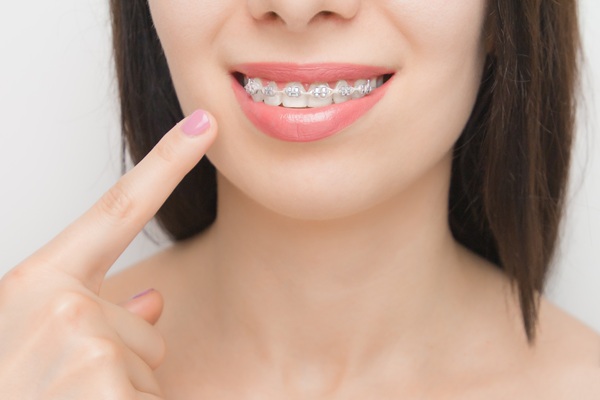Clear Braces vs. Aligners

Choosing between clear aligners and clear braces can feel overwhelming to some when exploring orthodontic care. While clear braces and aligners both straighten teeth and align bites, they differ in design, maintenance, and treatment scope. Understanding how each treatment option works will help patients make informed choices on their orthodontic care.
Clear braces vs. aligners: Visibility and material differences
Clear aligners are plastic trays that fit tightly over the teeth. These trays are nearly invisible to the naked eye, making them appealing to patients who want a discreet appearance. On the other hand, clear braces use ceramic brackets that blend with the teeth. Clear braces are more incognito than traditional metal braces, but can be seen.
Further, while aligners are removable by the patient, braces stay in place for the entire treatment. Patients who prefer the ability to eat and brush without interference often consider aligners. However, the fixed nature of braces can benefit individuals who tend to be forgetful or avoid wearing trays consistently. Clear aligners are not magic and do need to be worn 20-22 hours per day to be an effective treatment option, without significantly increasing treatment length.
Clear braces vs. aligners: Treatment scope and predictability
Clear aligners are a great option for some cases, but not every orthodontic case is fit for aligners. While aligners can be an option for many cases, even ones that require more complex movements, in some situations, aligners can struggle to move teeth vertically or with difficult rotations, especially with molars.
Clear braces, in contrast, provide orthodontists with greater precision in controlling tooth movements. Since braces are affixed to the patient’s teeth, they apply continuous pressure, helping achieve more predictable results for complex cases. Orthodontists typically recommend braces when alignment problems involve bite correction, tooth rotation, or more advanced movements.
Clear braces vs. aligners: Patient responsibility
Aligner success depends on how well a patient follows directions. Orthodontists typically recommend wearing aligners 20 to 22 hours per day. Removing trays too often or failing to consistently keep the aligners in the mouth can prolong treatment time or yield less-than-desirable results.
By comparison, clear braces rely much less on patient compliance. Once applied, braces work continuously without the need for frequently taking trays in and out of the mouth. Patients with busy lifestyles, who play contact sports, or who are prone to misplacing items, may benefit from the simplicity of traditional braces. Dr. McMahon at Anchored Orthodontics likes to say “with braces, the patient is the passenger, but with aligners, the patient is in the driver's seat.”
Clear braces vs. aligners: Oral hygiene and maintenance
Clear aligners make brushing and flossing more convenient. Since aligners are removable, patients can maintain their normal hygiene routines. However, they must remember to clean the actual aligner trays regularly to prevent staining or bacterial buildup.
Clear braces require more detailed hygiene practices. Food can get trapped around brackets and wires, increasing the risk of plaque and decay with poor oral hygiene. Special brushes or floss threaders may be needed to clean properly. Anchored Orthodontics will provide tips and tools to help patients keep their smile healthy throughout the process. With either braces or clear aligners, patients should still see their general dentist for routine cleanings during treatment.
Clear braces vs. aligners: Comfort and adjustments
Many patients report that aligners feel smoother than braces. The plastic trays avoid the sharp edges of brackets or the potential irritation from wires. Adjustments with aligners simply involve switching to the next tray rather than adjusting brackets and tightening wires. Tooth movements with aligners tend to be much more gradual, while braces can move teeth rather quickly.
Clear braces may feel slightly less comfortable during certain phases of treatment. Adjustments can cause pressure or soreness for a few days following the appointment. However, modern braces use advanced materials that reduce friction and promote gentle movements.
Straighten your teeth at Anchored Orthodontics
Clear braces and clear aligners are both excellent options for straightening teeth or fixing bite issues. However, one treatment type may better suit your needs over the other. If you are interested in learning more about each option or scheduling a complimentary consultation, please contact Anchored Orthodontics today.
You can directly schedule or request a free consultation at Anchored Orthodontics website: https://anchoredorthodontics.com or call Anchored Orthodontics at (612) 200-0020 for an appointment in our Minnetonka office.
Check out what others are saying about our dental services on Yelp: Clear Braces in Minnetonka, MN.
Related Posts
There are several myths and misconceptions about orthodontics. This is the process of correcting teeth alignment issues using appliances like clear alignments and metal braces. Treatment with orthodontics sometimes also leads to improvements in a person’s facial structure and appearance.Misaligned teeth can ruin how a smile looks and can also increase the risk of issues…
Orthodontics typically involves wearing oral appliances like braces or clear aligners in order to straighten teeth. These devices work by constantly pushing on the wearer’s teeth, moving them to more desirable positions over time. Teeth misalignment can lead to a less aesthetically pleasing smile and a variety of oral issues, like gum disease. Getting appropriate…
Phase Two orthodontics is the the second stage in comprehensive orthodontic treatment, typically following an initial intervention often referred to as Phase One orthodontics. The primary objective of Phase Two orthodontics involves perfecting alignment, correcting any remaining bite issues, and achieving optimal aesthetics and function once a patient has reached full adult dentition. Patients often…
Every person has unique reasons for seeking orthodontics. Some seek treatment to enhance the way that their smile looks, while others might want to address more serious issues, like not being able to speak properly due to teeth misalignment. Dentists often recommend orthodontics if they notice abnormalities like poor teeth alignment or a lack of…





